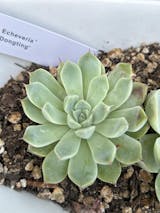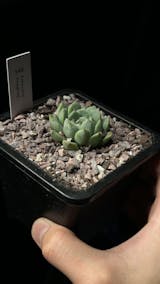About Echeveria'Dongting'
Echeveria' Dongting', a succulent of Echeveria Genus in the Crassulaceae family, has ovate leaves with tips. There are grooves in the middle of the leaves. The leaves close in the middle and appear blue-green or whitish. When it thrives, its color will change to attractive pink, with some red spots and a beautiful near-transparent jelly color.
How to care for Echeveria 'Dongting'
Sun/Temperature: Echeverias need a lot of light to grow well. They should receive at least 4-5 hours of bright, direct sunlight daily, ideally 6 hours. If they don't get enough sunlight, they will become leggy instead of staying compact and may not produce flowers. Spring and autumn are growing seasons, and it is necessary to take temperature control measures in summer and winter. It would help if you strengthened ventilation in Summer. It is best to keep it below 90°F; in winter need to move it indoors and indoor temperature control above 41°F.
Watering/Soil: Overwatering is the biggest issue with succulents, so make sure to let the soil dry out completely before irrigating again. To prevent rot or fungal diseases that can be fatal to the plant, it is important to not allow water to accumulate in the rosette. At the same time, choose a soil with good air and water permeability to plant Echeveria 'Dongting'.
Fertilizer: Fertilizing Echeveria 'Dongting' regularly is unnecessary because it's used to grow in soil lacking nutrients. And most potting soils come with ample nutrients, which plants use to produce new growth. Once your Echeveria 'Dongting' has used up the nutrients in its soil or doubled in size, it's time to repot it into a bigger container. This should be done once a year to provide it with fresh nutrients.
Pest Control: Echeveria 'Dongting' is more resistant to pests and diseases, but some common pests and diseases can also attack it. It is necessary to detect and take control measures in time to ensure the healthy growth of plants. In case of pests and diseases, fungicides and insecticides can be purchased and used as directed in the instructions.
Propagation: It can be propagated by leaf. First, gently shake the leaf with your hand until the leaf is removed, then place the leaves in a cool and ventilated place and wait for the wound to scab over, which takes about a week. Next, find a large pot not too deep as a container and prepare the appropriate medium. Generally, a combination of peat soil, perlite, and vermiculite (ratio: 2:1:1) is used. If you have diatomaceous or Akadama soil, add some. Finally, put the leaves on the soil and wait a couple of days; it will grow roots.
More information
Primary color: Pink
Secondary color: Green
Bloom color: Pink
Cold hardiness: zone11a-13b
Product format: 2" pot
Suitability: balcony, Window, Garden
Propagation: cutting, leaf, seed
Special characteristic: easy to propagate, pet safe





